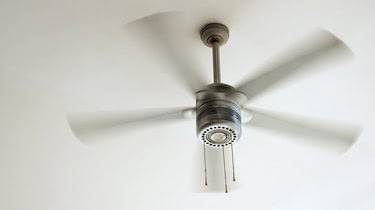Quck answer
To balance a ceiling fan, follow these steps:
1. Turn off the fan and allow it to come to a complete stop.
2. Clean the fan blades to remove any dust or debris that could affect balance.
3. Use a ladder to access the fan.
4. Use a balancing kit or a yardstick to find the heaviest blade.
5. Attach a balancing clip or weight to the top of the blade.
6. Turn on the fan and observe if there is still any wobbling.
7. Repeat steps 4-6 until the fan runs smoothly without any wobbling.
8. Once balanced, tighten any loose screws or bolts on the fan.
9. Enjoy a balanced and quiet ceiling fan!
When a ceiling fan becomes unbalanced, there are a few steps you can take to correct it. One common method is to attach a small weight to one or more of the fan blades. These weights can be found in kits that are affordable and typically include a plastic clip to help determine where to place each weight. It’s also possible to balance a fan using items you already have at home. However, it’s important to note that before attempting to balance your fan, you should clean and inspect the blades and ensure that the fan is securely mounted. A dirty fan or loose parts can often be the cause of a wobbly fan.

Image Credit:
kirill4mula/iStock/GettyImages
Cleaning and Inspecting the Blades
Ceiling fans are sensitive and can easily become unbalanced due to the buildup of dust and grime. Even if the blades appear clean from below, it’s possible that they may be dirty when viewed from above. To clean the blades, use a dust cloth or a slightly damp rag to wipe both sides and remove any dust or oils.
Inspect each blade to ensure that it is flat and not warped. Additionally, check that each blade is securely fastened to both its bracket and the motor unit of the fan. Blades are typically fastened with screws, but some may have keyhole slots that fit onto brackets. Brackets are usually secured to the motor with screws. If any blade is significantly warped or cannot be tightened to its bracket, it should be replaced.

Keep the blades of your ceiling fan clean to maintain smooth operation.
Image Credit:
powershot/iStock/GettyImages
Checking the Fan Mounting
Often, wobbly ceiling fans are a result of being improperly mounted, and this can pose a safety hazard. Most ceiling fans are mounted using a metal bracket that connects the motor unit to the electrical box in the ceiling. The bracket is secured to the box with two or more machine bolts. Over time, these bolts can loosen, causing the bracket (and the fan) to move. The electrical box itself can also become loose, which is a more significant problem.

A non-contact voltage tester can be used to test for power before making electrical repairs.
Image Credit:
Fluke
To check the condition of the fan mounting, start by turning off the power to the fan’s circuit by switching off the appropriate breaker in your home’s breaker box. Then, loosen the screw(s) of the decorative cover or shroud on the ceiling (above the fan) and slide the cover down, away from the ceiling. This will expose the electrical box, fan, and circuit wires. Use a non-contact voltage tester to ensure that the power is off.
Next, use a screwdriver to tighten the bolts that secure the mounting bracket to the electrical box. Once tightened, try to move the box from side to side by grabbing the mounting bracket. If the box moves, it may indicate that it is the wrong type of box for a ceiling fan or that it is improperly mounted, or both. In this case, the fan installation is not safe, and it is recommended to reinstall the fan using a ceiling-fan-rated box anchored to the ceiling joists instead of the drywall.
If everything appears to be in good condition, secure the decorative cover back into position and restore power to the fan circuit. Test the fan to see if it still wobbles. If it does, it’s time to proceed with balancing the blades.
Achieving Balance for Your Fan with a Balancing Kit
This process is relatively simple, but it may require some trial and error to find the perfect balance. The key is to assess each blade using the plastic clip provided in the kit to identify the blade causing the imbalance. Once identified, you can adjust the clip’s position on that blade to determine the optimal placement for the balancing weight.

Begin by attaching the clip to the rear edge (lower edge) of one of the blades. Turn the fan on to its highest speed (assuming it wobbles most at this speed; if it wobbles more at a lower speed, use that speed for testing). Observe the fan to see if the wobble disappears. If not, turn off the fan and move the clip to the next blade, repeating the process as necessary.
Once you have identified the problematic blade, experiment with different positions for the clip on that blade. Slide the clip closer to or farther from the fan motor and check for wobbling with each adjustment. The position that provides the most stability for the fan is where you should attach the balancing weight. Remove the non-stick backing from one of the weights and affix it to the top side of the blade, aligning it with the clip and placing it in the center from front to back.
Perform a final test on the fan (hopefully, it will be wobble-free). If there is still a slight wobble, repeat the balancing process and add a weight to one or more of the other blades.
DIY Methods for Balancing a Ceiling Fan
If you do not have a balancing kit or prefer not to purchase one, you can follow the same balancing steps using alternative materials. Substitute a small binder clip for the plastic clip in the kit and use a penny or metal washer as the weight. A standard 3/4-inch binder clip weighs approximately 2 to 3 grams. A penny weighs 2.5 grams (pennies minted before 1981 weigh 3.1 grams). Balancing kits typically contain weights that weigh around 3 grams. If you attach a penny to the blade using a small amount of hot glue, the total weight will be close to 3 grams. Hot glue is recommended because it can be easily removed.
Another option is to use poster putty or reusable adhesive putty, such as Blu-Tack or Fun-Tak. Shape the putty into a small ball and stick it onto the top side of the blade. You can use the putty for both the balancing test and as a permanent weight.


